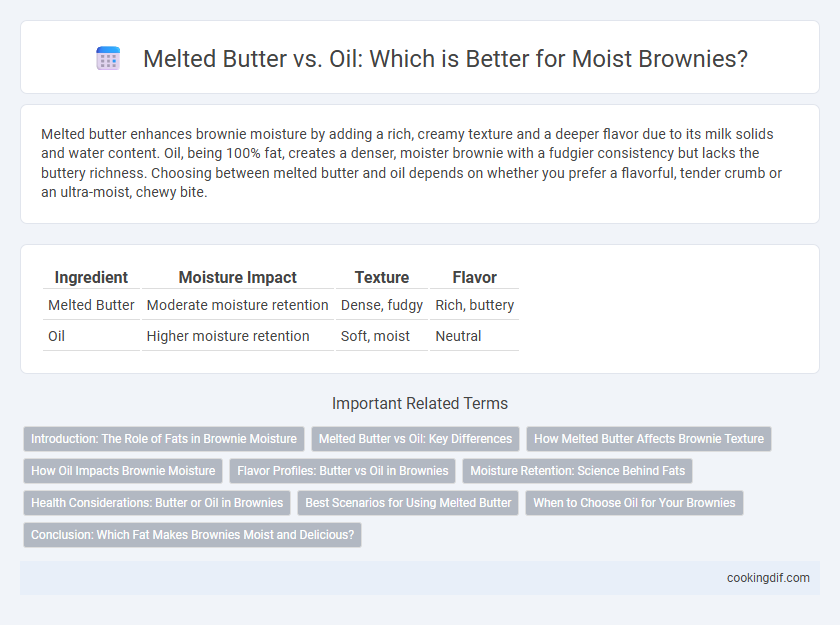Melted butter enhances brownie moisture by adding a rich, creamy texture and a deeper flavor due to its milk solids and water content. Oil, being 100% fat, creates a denser, moister brownie with a fudgier consistency but lacks the buttery richness. Choosing between melted butter and oil depends on whether you prefer a flavorful, tender crumb or an ultra-moist, chewy bite.
Table of Comparison
| Ingredient | Moisture Impact | Texture | Flavor |
|---|---|---|---|
| Melted Butter | Moderate moisture retention | Dense, fudgy | Rich, buttery |
| Oil | Higher moisture retention | Soft, moist | Neutral |
Introduction: The Role of Fats in Brownie Moisture
Melted butter enhances brownie moisture by contributing rich flavor and a tender crumb due to its milk solids and water content, which create steam during baking. Oil provides a denser, consistently moist texture because it remains liquid at room temperature, trapping more moisture in the batter. Understanding how these fats interact with other ingredients helps achieve the desired brownie texture and moisture level.
Melted Butter vs Oil: Key Differences
Melted butter enhances brownies with a rich, creamy texture and a deep, buttery flavor that contributes to a denser crumb, while oil produces a moister, softer bite with a lighter texture due to its liquid state at room temperature. Butter provides structure through milk solids, which can create a slightly firmer brownie, whereas oil, being purely fat, results in increased tenderness and prolonged freshness. Choosing melted butter versus oil depends on whether a rich flavor and firmer texture or enhanced moisture and softness are prioritized in the brownie.
How Melted Butter Affects Brownie Texture
Melted butter contributes to a denser, fudgier brownie texture by allowing the fat to blend evenly with sugar, creating smaller air pockets during baking. Its milk solids promote browning and add a rich, caramelized flavor that enhances the overall taste. The use of melted butter results in chewy edges and a moist interior, distinguishing it from the lighter crumb achieved with oil-based brownies.
How Oil Impacts Brownie Moisture
Oil enhances brownie moisture by coating the flour proteins more thoroughly than melted butter, which reduces gluten formation and results in a denser, fudgier texture. Unlike butter, oil remains liquid at room temperature, contributing to a consistently moist crumb that resists drying out. The higher fat content in oil also helps retain moisture longer, making brownies softer and more tender over time.
Flavor Profiles: Butter vs Oil in Brownies
Melted butter imparts a rich, creamy flavor and a slightly caramelized note to brownies, enhancing their overall depth and indulgence. Oil provides a more neutral taste, allowing other ingredients like chocolate or sugar to shine without additional flavor interference. Choosing butter results in a more complex, buttery flavor profile, while oil produces a lighter, more straightforward brownie taste.
Moisture Retention: Science Behind Fats
Melted butter enhances brownie moisture retention by solidifying as it cools, creating a tender crumb through water content and milk solids that contribute to texture. Oil, being 100% fat, prevents moisture loss by coating flour proteins and inhibiting gluten formation, resulting in a consistently moist and denser brownie. Scientific studies show the physical state of fat influences moisture entrapment, with butter adding a rich mouthfeel and oil maximizing moisture preservation.
Health Considerations: Butter or Oil in Brownies
Melted butter in brownies provides rich flavor and contributes to a denser, fudgier texture but contains saturated fats that may impact heart health when consumed in excess. Oil offers a lighter, moist crumb with healthier unsaturated fats that support better cholesterol levels and cardiovascular wellness. Choosing oil over butter can make brownies a more health-conscious treat without sacrificing moisture or taste.
Best Scenarios for Using Melted Butter
Melted butter enhances brownie moisture by providing a rich, creamy texture and a deep, buttery flavor that oil cannot replicate. It is best used in recipes aiming for a dense, fudgy consistency where the butter's milk solids contribute to a more complex taste and slight crispness on the edges. Brownies made with melted butter also benefit from better crumb structure and a glossy top, ideal for traditional, indulgent dessert preferences.
When to Choose Oil for Your Brownies
Oil is ideal for brownies when you prefer a denser, moister texture that stays soft for days due to its liquid state at room temperature. Choose oil if you want to enhance the richness and create a fudgy bite without the risk of butter solids altering the crumb. Oil also works better in recipes with cocoa powder rather than melted chocolate, as it blends seamlessly for a consistent, tender result.
Conclusion: Which Fat Makes Brownies Moist and Delicious?
Melted butter infuses brownies with a rich, deep flavor and a slightly denser, fudgier texture that enhances moisture retention. Oil tends to produce a lighter, more tender crumb but lacks the same depth of buttery taste, resulting in brownies that feel moist but less flavorful. For the perfect balance of moistness and indulgent taste, melted butter is the preferred fat choice in brownie recipes.
Melted butter vs Oil for brownie moisture Infographic

 cookingdif.com
cookingdif.com